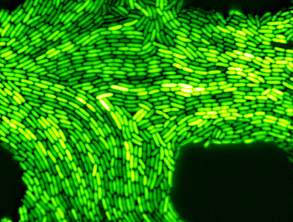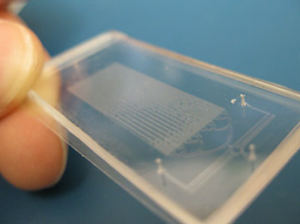Using a biopixel display composed of millions of living E.coli bacterial cells that fluoresce in unison like a blinking Las Vegas neon sign, bioengineers at UC San Diego have created a bacterial sensor that can easily detect low levels of arsenic. This achievement, explained in the online issue of the journal Nature, encompasses several steps: attaching a fluorescent protein to the E.coli's biological clocks and synchronizing the clocks of the thousands of bacteria within a colony, then synchronizing thousands of the blinking colonies to glow on and off in unison. To see their "glowing" work that caps five years of research, watch their video press release, above.

The science behind the glowing results
Initially, the team expand its repertoire of tools by developing a way to construct a robust and tunable biological clock to produce flashing, glowing bacteria (see lab video). Next, they designed and constructed a network based on a bacterial communication mechanism, which enabled them to synchronize all of the biological clocks within a bacterial colony so that thousands of bacteria would blink on and off in unison.

Lead researcher Jeff Hasty explained,"Many bacteria species are known to communicate by a mechanism known as quorum sensing, relaying small molecules to trigger and coordinate behaviors. Other bacteria are also known to disrupt this communication mechanism by degrading these relay molecules." Taking these two elements from different organisms, Hasty and his team constructed a network in the bacterium E. coli with positive and negative feedback components to produce a colony of synchronized clocks. Watch video: Because quorum sensing is comparatively slow, the researchers found the same method couldn't be scaled up and used to instantaneously synchronize millions of bacteria from thousands of colonies. Fortunately, they discovered each colony emits gases that, when shared among the thousands of other colonies within a microfluidic chip, can synchronize all of the millions of bacteria in the chip.

So, while the individual cells are synchronized via quorum sensing, the entire collection of colonies is synchronized via a gas signal. The team designed special microfluidic chips to combine the two processes. The largest chips contain 50 to 60 million bacterial cells and are about the size of a paper clip or a microscope cover slip. The smaller chips, which contain approximately 2.5 million cells, are about a tenth of the size of the larger chips. Each of the blinking bacterial colonies comprise what the researchers call a "biopixel," an individual point of light much like the pixels on a computer monitor or television screen. The larger chips contain about 13,000 biopixels, while the smaller chips contain about 500 pixels.

Using the same method to create the flashing signs, the researchers engineered a simple bacterial sensor capable of detecting low levels of arsenic. In this biological sensor, decreases in the frequency of the oscillations of the cells' blinking pattern indicate the presence and amount of the arsenic. "These kinds of living sensors are intriguing as they can serve to continuously monitor a given sample over long periods of time, whereas most detection kits are used for a one-time measurement," said Jeff Hasty. "Living sensors can provide a continual update on how dangerous a toxin or pathogen is at any one time." At UCSD, synthetic biology has gone beyond classic genetic engineering by building living systems that perform functions not found in nature. Hasty said he believes that within five years, a small hand-held sensor could be developed that would take readings in the field on disposable microfluidic chips to determine the presence and concentrations of various toxic substances and disease-causing organisms. (Read most recent press release.)


